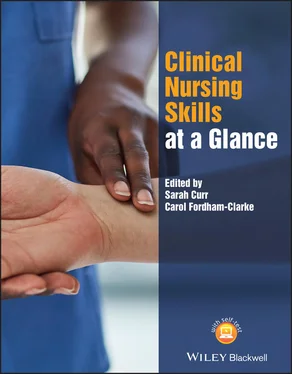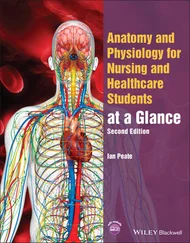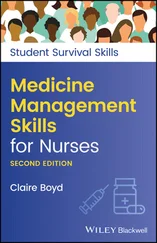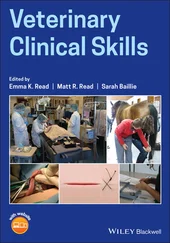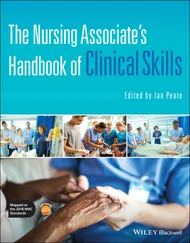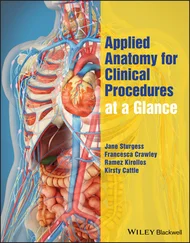Appropriate assessment paperwork.
Patient’s notes.
Care planning paperwork.
This will involve using the relevant assessment documents within your clinical area. The questions asked may reflect Henderson's needs theory (Henderson 1966) ( Figure 2.2), Orem's theory of self‐care deficit (Orem 2001) ( Figure 2.3), or Roper, Logan & Tierney's Activities of Daily Living model (Roper et al. 1980) ( Figure 2.4). All these models focus on the fact that nursing care is provided while the patient cannot self‐care or meet their daily needs.
The diagnosis involves considering what has been observed and what information has been given during the initial assessment to identify the problem.
The diagnosis focuses on key characteristics that enable the nursing diagnosis to be made.
It is the diagnosis, or diagnoses, that inform the care plan.
Procedure – Care Planning
More than one care plan may well need to be created to ensure that the patient's individualised needs are met.
Care plan charts will most likely be available in your clinical area but the key elements to consider are:What is the issue to be addressed?What interventions will resolve this issue?When would be it be appropriate to evaluate care?
Procedure – Implementation
This is your ongoing care for the patient.
Essentially by performing a thorough assessment, diagnosis and care plan, appropriate, necessary, person‐centred care should be delivered.
This is when you review the care plan and determine if the initial issue has now resolved, remained the same, or worsened.
Essentially the evaluation will then lead to an assessment and continuation of the process.
If the patient becomes unresponsive during initial assessment the BLS (Basic Life Support) algorithm and the A–E (airway, breathing, circulation, disability, exposure) assessment should be used.
A holistic assessment may take time as well as several discussions, depending on the patient's condition and priorities of care.
1 Gebbie, K. and Lavin, M.A. (1973). Classifying nursing diagnoses. The American Journal of Nursing 74 (2): 250–253.
2 Henderson, V. (1966). The Nature of Nursing. New York: Macmillian.
3 Levine, M.E. (1965). Trophicognosis: an alternative to nursing diagnosis. ANA Clinical Conferences 2: 55–70.
4 NHS England (2016). Personalised Care and Support Planning Handbook: The Journey to Person Centred Care. NHS England: Leeds.
5 Orem, D. (2001). Nursing: Concepts of Practice. St Louis: Mosby.
6 Orlando, I.J. (1961). The Dynamic Nurse‐Patient Relationship, Function, Process and Principles. New York: Putnam Press.
7 Roper, N., Logan, W., and Tierney, A.J. (1980). The Elements of Nursing. London: Churchill Livingstone.
3 Communication – fundamentals
Table 3.1 Examples of paraphrasing.
|
Patient |
Healthcare worker |
| Summarising |
“I'm the bread winner, I'm not sure what will happen to my family.” |
“You are worried about how your family with cope financially.” |
| Interpreting |
“I'm waiting on the results. I've been waiting a while.” |
“You're worried about when you're getting your results.” |
Table 3.2 Clarification questions.
| “So, what you're saying is…?” |
| “Am I correct in understanding that…?” |
| “So what you mean by that is…?” |
| “What I'm hearing is…, is that correct?” |
| “I'm not quite sure I follow, could you give me more details?” |
Table 3.3 SOLER – a tool to build rapport Identified by Egan (2014).
| S |
Sitat a comfortable angle and distance |
| O |
Maintain an openposture, i.e. uncrossing legs and arms |
| L |
Leanforward appropriately to show engagement |
| E |
Maintain eyecontact. The healthcare professional must be aware of when this might not be culturally appropriate |
| R |
Maintain a relaxed posture. This will help with building rapport and trust. |
Communication is undertaken with every social interaction and effective communication is affected by how the message is sent and how it is received (Gates et al. 2003). Communication is recognised by the Nursing & Midwifery Council as an essential skill (2018) and involves written, verbal, and non‐verbal communication, with patients/clients/service users, relatives, carers, and other members of the immediate and wider multi‐professional team.
How we communicate depends on the client group we are communicating with and can change when:
Communicating with people from different cultures.
Communicating with people who speak different languages.
Communicating with those with learning disabilities.
Communicating with children.
Communicating with those with dementia and/or delirium and other neurological impairments.
There is a lack of time – it will be apparent by your body language if you feel that you do not have time for the interaction. This can be mitigated by providing a more suitable time for the conversation.
In nursing how we communicate will impact upon the therapeutic relationship and trust built between the professional and the patient. How we communicate should be considered at the beginning of each episode of care and must be open, honest and non‐judgemental. There are numerous factors that we must consider:
The environment – where is the best place for this conversation?
Physical discomfort, e.g. pain – consider giving analgesia before the conversation.
Psychological discomfort, e.g. anxiety – adjusting body language, volume, articulation, pitch, emphasis and rate (VAPER) (Nelson‐Jones 2014) of verbal communication can help here.
Emotional discomfort, e.g. grief.
Physical impairments, e.g. sight or hearing impairment– consider proximity, visual aids.
Jargon – avoid professional language the patient may be unfamiliar with as this will create an additional barrier.
Procedure: Verbal Communication
Verbal communication can be face‐to‐face, over the telephone, or through other media forms, e.g. Facetime, Skype:
Listening – this is a key aspect of verbal communication as it shows we are attentive and interested in the message being conveyed. It also demonstrates that we receive the message, understand it, support the person we are communicating with, and thus validate the message being delivered.
Active listening involves paraphrasing, where the key points are repeated back to show that the correct message is being received ( Table 3.1).
Active listening can also involve the use of paralanguage such as: “mmh”, “yes”, “uh‐huh”, to show that you are listening.
Verbal communication may initially start with closed questions, such as “Were you inside or outside?”, which can be used at the outset, and open questions, such as “How did you feel when that happened?”, to build rapport and engagement.
Open questions are then used to gain more detailed information and insight into how the person is feeling.
Читать дальше
